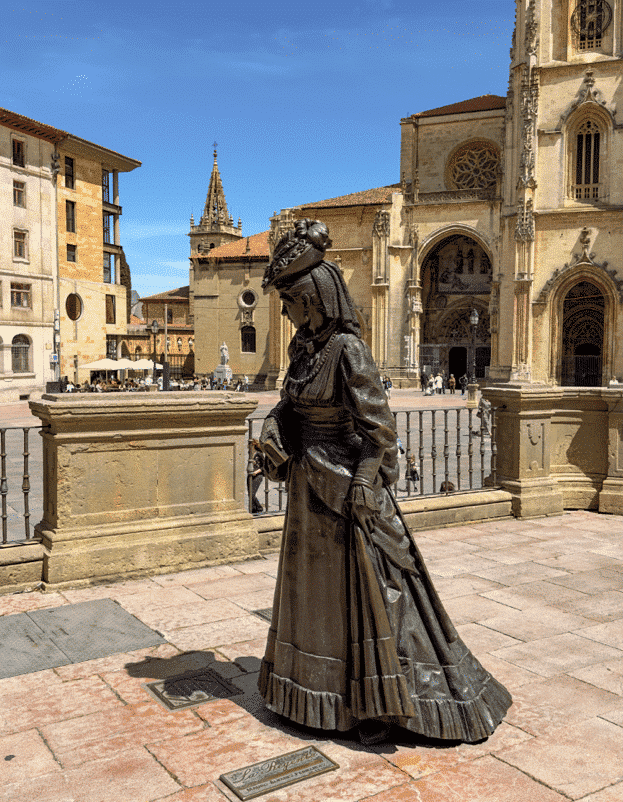Introduction to Escultura de La Regenta
The city of Oviedo, located in the heart of Spain’s northern region, Asturias, is a treasure trove of architectural and historical marvels. Among its many attractions stands a remarkable piece of art that has become an emblematic symbol for both locals and visitors alike – the Escultura de La Regenta.
A Tribute to Literature
The sculpture pays tribute to one of Spain’s most significant works in literature – ‘La Regenta’, written by Leopoldo Alas “Clarín”. This 19th-century masterpiece explores themes such as love, religion, and societal norms through the life experiences of its protagonist Ana Ozores – also known as La Regenta. The novel is set against the backdrop of Vetusta (a fictional name for Oviedo), making this sculpture not just an artistic installation but also a tangible connection between fiction and reality.
About The Sculpture
Created by renowned Spanish sculptor Mauro Álvarez Fernández in 1997, this larger-than-life bronze statue captures Ana Ozores’ character with exceptional detail. She is depicted deep in thought with her eyes closed and hands clasped together – possibly reflecting her inner turmoil from the novel. The statue measures approximately two meters high and weighs around 200 kilograms.
Location And Significance
The monument occupies a prominent position at Plaza de la Catedral or Cathedral Square right next to Oviedo’s majestic Gothic-style cathedral. It’s no coincidence that it resides here; it serves as a constant reminder of how deeply rooted ‘La Regenta’ is within Oviedo’s cultural identity.
A Magnet For Tourists And Locals Alike
This impressive work of art has become a popular spot for tourists and locals alike. Visitors are often seen taking photographs with the statue, while locals appreciate it as a symbol of their rich literary heritage.
A Controversial Past
Despite its current popularity, the Escultura de La Regenta was not always well-received. When first unveiled in 1997, it faced considerable criticism from some quarters who felt that the sculpture’s modernist style did not fit in with Oviedo’s historical architecture. Over time however, these criticisms have largely subsided and today this thoughtful representation of Ana Ozores is widely accepted as an integral part of Oviedo’s cultural landscape.
In Conclusion
The Escultura de La Regenta is more than just a sculpture; it is a testament to Spain’s rich literary history and Oviedo’s deep love for its cultural roots. Whether you’re a fan of Spanish literature or simply enjoy exploring new places steeped in history and culture, don’t miss out on visiting this iconic monument when you’re next in Oviedo!
Frequently asked questions
What is the Escultura de La Regenta and where is it located?
The Escultura de La Regenta is a bronze statue dedicated to the main character of ‘La Regenta’, one of the most famous novels in Spanish literature by Leopoldo Alas Clarín. The sculpture, created by Mauro Álvarez Fernández in 1997, represents Ana Ozores (the protagonist), standing with her parasol. It’s located in Oviedo, Spain, specifically at Plaza de la Catedral or Cathedral Square.
What are the opening hours for visiting Escultura de La Regenta?
As an outdoor public monument situated on Cathedral Square, there are no specific opening hours for visiting the Escultura de La Regenta. Visitors can view it any time they wish throughout day or night. However, you might want to plan your visit during daylight hours as that would offer better opportunities for photography and understanding its intricate details.
How significant is this sculpture to Oviedo’s cultural heritage?
This sculpture holds immense significance as a symbol of Oviedo’s rich literary history because ‘La Regenta’ was set in a thinly disguised version of this city named Vetusta. Through his novel and its characters like Ana Ozores represented by this statue, Leopoldo Alas Clarin painted a vivid picture of late 19th century provincial life in Spain which resonates with many people even today. Therefore, locals regard it not just as an artwork but also as part of their shared cultural identity.
Can I take pictures when visiting the Escultura de La Regenta?
Absolutely! You’re free to take photographs when visiting the Escultura de La Regenta. In fact, due to its historical and cultural significance, it’s a popular spot for photography among both locals and tourists. The statue is located in an open square with the beautiful backdrop of Oviedo Cathedral, providing excellent opportunities for memorable photos.
Are there any other attractions nearby?
Yes, the Escultura de La Regenta is situated in one of the most historically rich areas of Oviedo. Apart from admiring this sculpture, you can also visit the stunning Oviedo Cathedral that stands right behind it. Other nearby attractions include the Archaeological Museum of Asturias, Plaza del Fontan Market where you can enjoy local produce and cuisine, Campoamor Theater which hosts annual Prince of Asturias Awards ceremony and many more.












